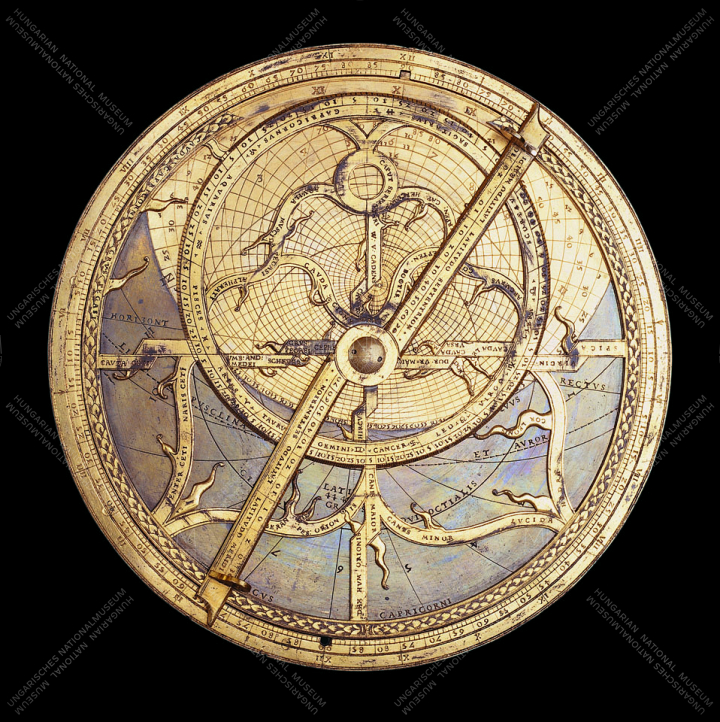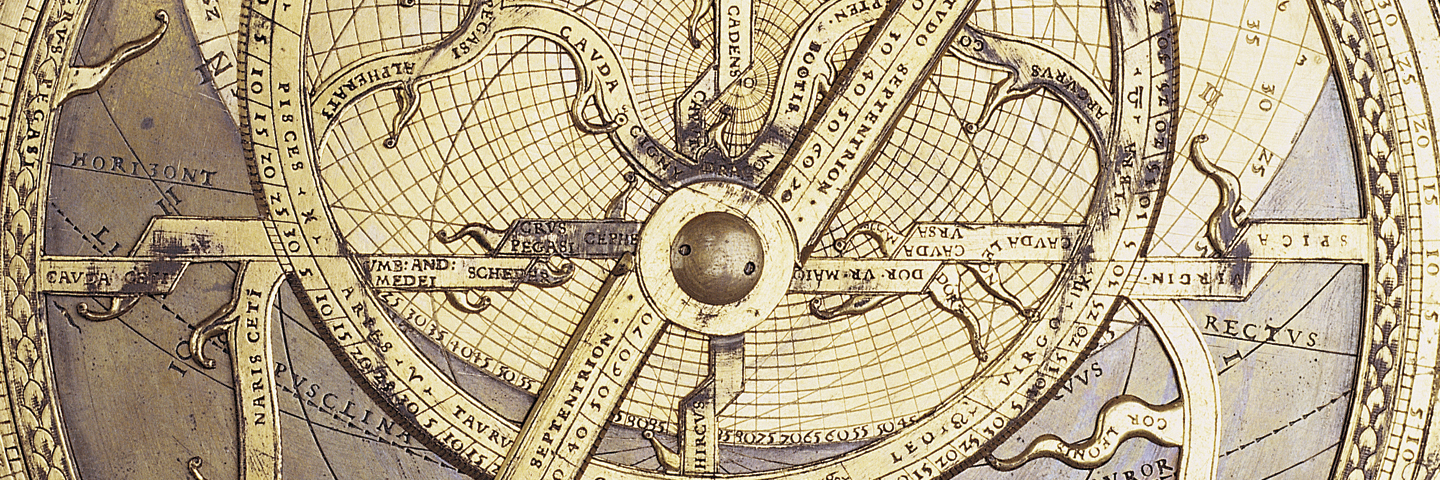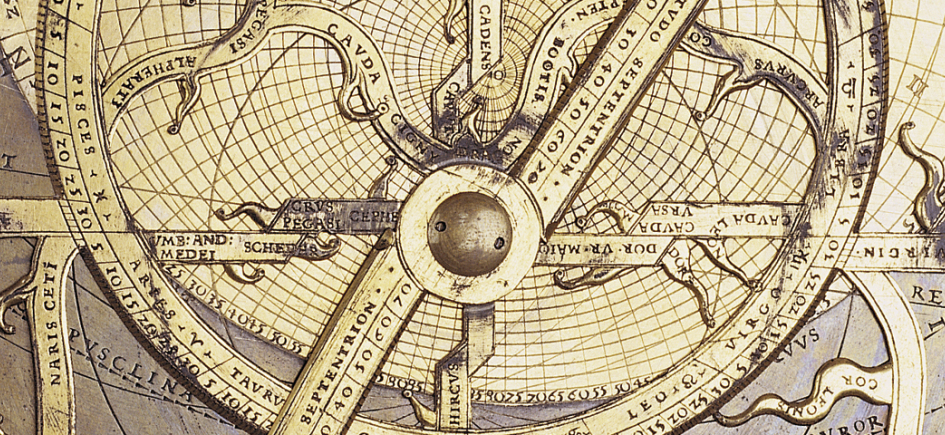
The Historical repository
The Historical repository short description
Clocks are not only useful objects to measure time, they are also objects of art. Collecting clocks and watches has a long tradition, it is a high-life passtime. The first registry book of the Hungarian National Museum, the so-called Cimeliotheca mentions many „horologium” as early as 1825.
The collection includes
- different types of sun dials, including compendia and astrolabia,
- tools used for mapping of mines – csupán kettő, de ezek unikális darabok, melyek azt mutatják, hogy a 16. században Magyarország élen járt a bányaművelésben s az ehhez szükséges műszeriparban,
- mechanical clocks (wall clocks, table clocks, decorative and portable ones);
and some miscellaneous objects such as collection of an early 20th century photo workshop and an astrological telescope from the first half of the 19th century.
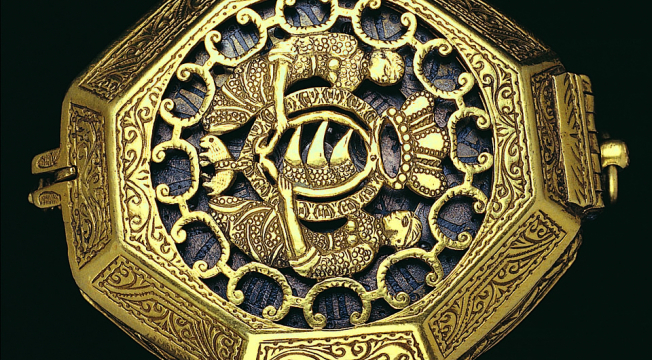 6
6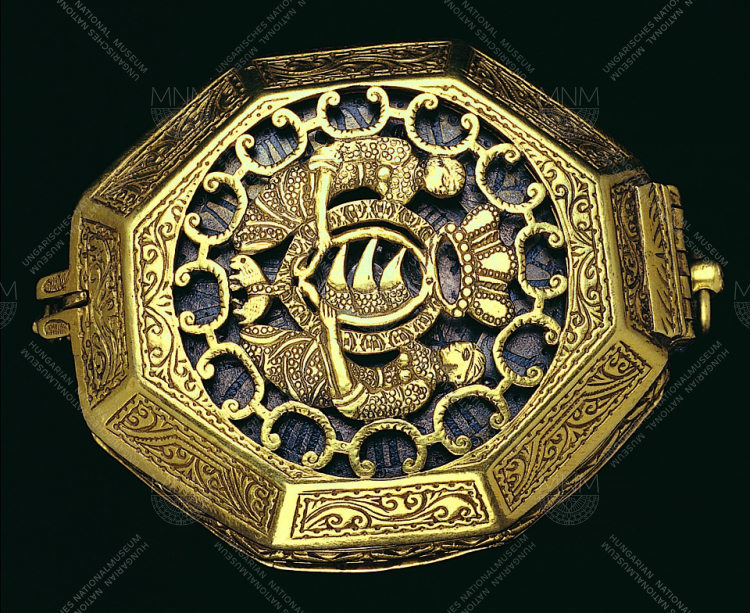
Pocket Watch
It was purchased by the National Museum from the collection of Miklós Jankovich in the 1830s. In the 18th century the earliest samples of pocket watches were worn around the neck or hanging from a belt by the aristocracy. These pocket watches were generally listed among jewellery in inventories because they had been made of silver, gold (often gold-plated copper), and often decorated with precious stones or enamel decorations; their lids covered with polished mountain crystals. The labour-intensive pieces mostly came from the centers of watch production: Augsburg or Nuremberg. However, watchmakers were already united in guilds in Hungary and Transylvania. This outstanding piece of our collection belonged to Zsigmond Báthori, Prince of Transylvania (1581-1602). Its case is octagonal shaped and made of enamelled brass. The lower part of the case had been made earlier,somewhere between 1570-1580, with pierced andengraved flower motifs. Its cover part is decorated with the dragon-tooth coat of arms of the Báthoris, surrounded by the chain of the Order of the Golden Fleece. Zsigmond Báthori received the rank of the Prince of Transylvaniaand the Order of the Golden Fleece in 1597, so the lid cover could have been made after that date. It is most likely a masterpiece made by a Transylvanian watchmaker master. It is constructed with only one hand, its twisted escapement supports a clockwork; its balance wheel is madewithout a hairspring.
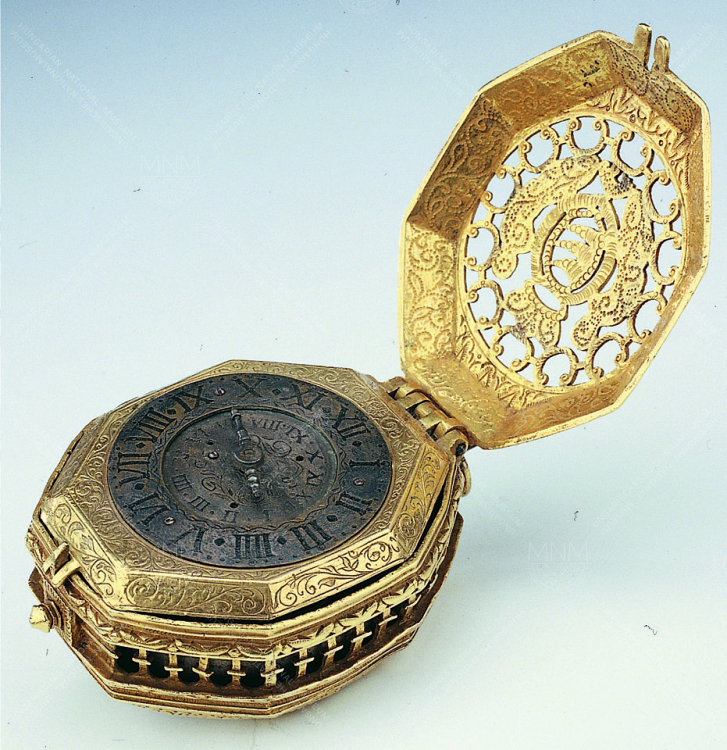
Pocket Watch
It was purchased by the National Museum from the collection of Miklós Jankovich in the 1830s. In the 18th century the earliest samples of pocket watches were worn around the neck or hanging from a belt by the aristocracy. These pocket watches were generally listed among jewellery in inventories because they had been made of silver, gold (often gold-plated copper), and often decorated with precious stones or enamel decorations; their lids covered with polished mountain crystals. The labour-intensive pieces mostly came from the centers of watch production: Augsburg or Nuremberg. However, watchmakers were already united in guilds in Hungary and Transylvania. This outstanding piece of our collection belonged to Zsigmond Báthori, Prince of Transylvania (1581-1602). Its case is octagonal shaped and made of enamelled brass. The lower part of the case had been made earlier,somewhere between 1570-1580, with pierced andengraved flower motifs. Its cover part is decorated with the dragon-tooth coat of arms of the Báthoris, surrounded by the chain of the Order of the Golden Fleece. Zsigmond Báthori received the rank of the Prince of Transylvaniaand the Order of the Golden Fleece in 1597, so the lid cover could have been made after that date. It is most likely a masterpiece made by a Transylvanian watchmaker master. It is constructed with only one hand, its twisted escapement supports a clockwork; its balance wheel is madewithout a hairspring.
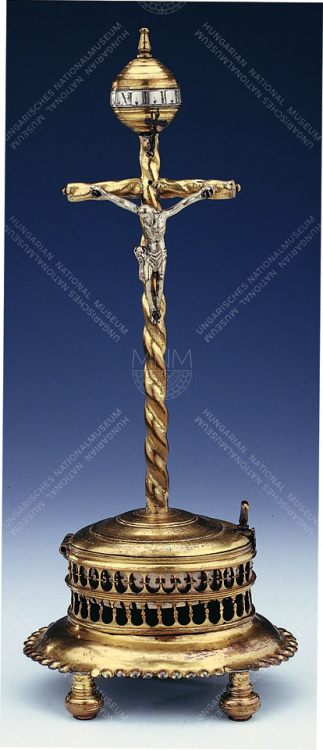
Cross clock
Master mark: "Me Fecit Adamus Bachmedjei A.D. 1693"
gold-plated brass with twisted clockwork
Cross clocks were very popular in Europe in the 16th-17th centuries. The pedestal houses a structure that rotates a sphere placed on top of the crucifixindicating the time (with Roman numbers)along a vertical axis. In fact there is a hand fixed in front of the sphere ring indicating the time..
In the middle of the 19th century, the parish priest of Ebed, Mihály Nagy donated his clock in his last will to the National Museum, therefore it was included in the collection. In the booklet published for the 100th anniversary of the National Museum (1902), a picture was published about the clock: "A skillfully composed clockdesigned in the shape of a cross with a small bell. We can read the name of a fine Hungarian master under the bell." According to the Latin inscription, Master Ádám of Bács County made it in the year 1693 of the Lord.
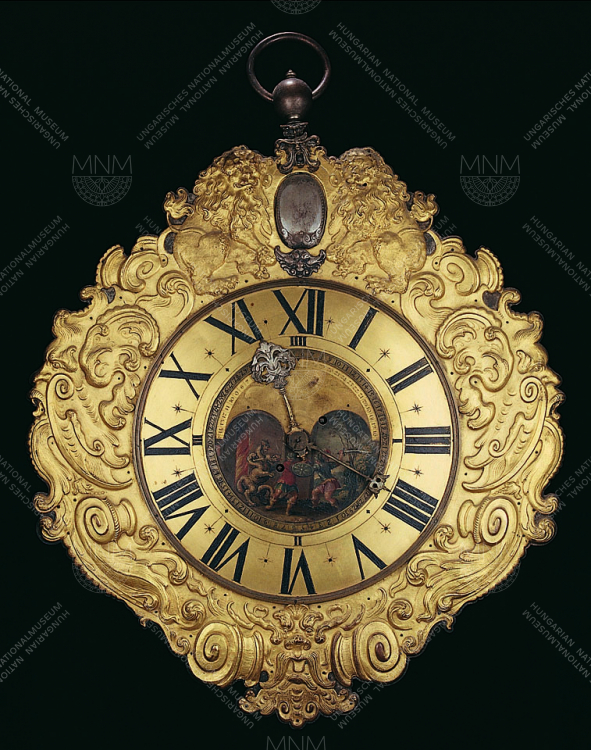
Wall Clock
master mark: Matthias Kieblich in Pressburg
second half of the 17th century, Bratislava
One of the earliest pieces of our collection is this gold-plated copper-framed watch, which had been owned by Ferenc Rákóczi II according to the tradition. In addition to the ornate frame, two lions hold an oval silver shield. On the dial two young gentlemen are figting a three-headed, fire-blowing dragon. The master mark engraved on the clockwork says: Matthias Kieblich in Pressburg.
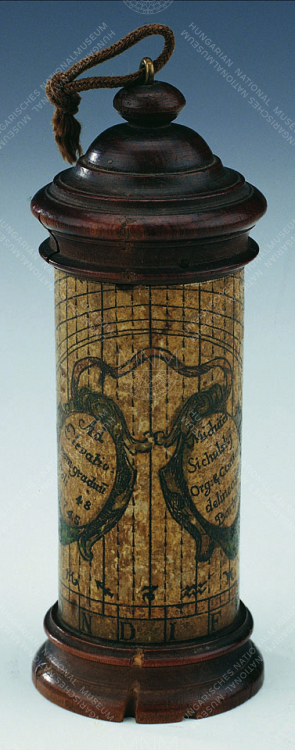
Cylindrical Sundial
signed by Michael Sichulsky, Bardejov, 1745.
For thousands of years, sundials were the most reliabletime measuring devices. The skill to design a sundial, gnomonics (a gnomon is a stick casting shadows around which circles are drawn to find about the position of the Sun judging by the shadows of the gnome), became the science in the ancient Hellas. The two large groups of sundials are the fixed and portable (portative) ones. There are many subtypes within each group. Portable sundials spread from the 15th century to a wider range when more and more accurate time measuring pieces were needed in everyday life. The heyday of pocket sundials was in the 18th century when the more expensive mechanical clocks were replaced with them.
The cylindrical sundial is based on the measurement of the Sun's height. The signs are distributed on the cylinder's hull and the shadow is cast on them by the gnomeplaced horizontallyon the upper part. This piece is also an outstanding piece being able to measure quartets as well. According to its Latin mark "it was draw by Mihály Sichulsky, an organist and singer in Bártfa (Bardejov), at 48 degrees of pole height in 1745.
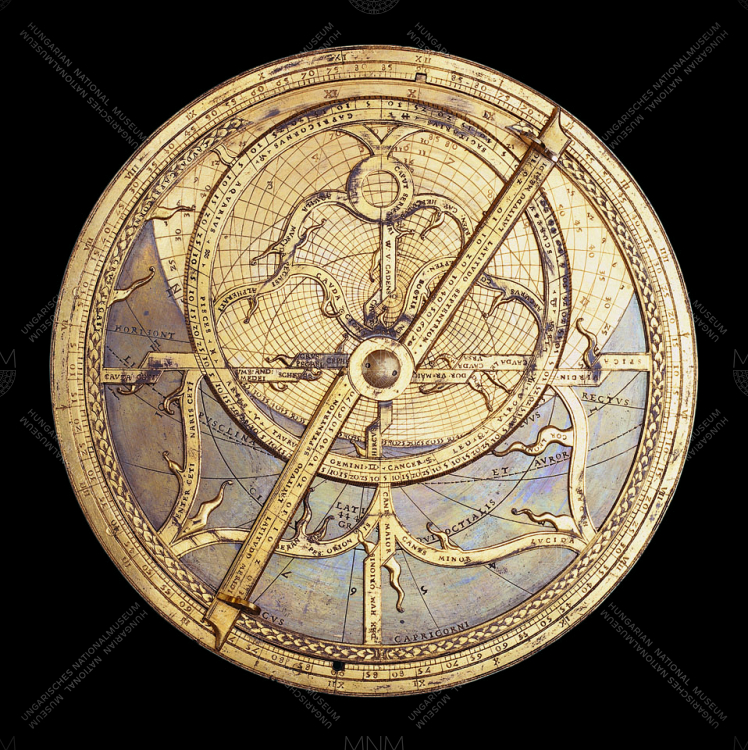
Astrolabe
no master mark
South German or Flemish work, 16th century
gilt copper
This sophisticated gold-plated brass disk: an astronomical clockcombined with an astrolabe is a significant piece of the clock collection of the Hungarian National Museum. An astrolabium is used to determine the paths and temporary places of planets, a model of the Ptolemaic universe, the most widely used scientific astronomical tool of the European Middle Ages and the Renaissance, aninstrument designed to make awide range of measuring and calculating tasks.
An astrolabium is built on a circular base plate („mater”) with an angular arrangement and clock division around the edge. To the front side of the base plate, an (or more) angled smaller plate, a tympanum can be fitted. It was where the horizontally casted picture of the sky's graduation was engraved. The zodiac ring depicts the zodiac constellationswith the names of zodiac signs.This ring – containingspikes representing 28bright star can be rotated ring, the net.
The arrangement of this instrument differs somewhat from the general system of astrolabes. Its back – containing a night clock (nocturnalium) – is unfortunately incomplete. There are two rotating disks on the back, one of hte watch arms is missing. It is decorated with the engraved picture of the Aries sign. The engraved Latin names also show that the instrument could have been made before the 17th century.
It is an interesting, unique piece.
Pocket Watch
It was purchased by the National Museum from the collection of Miklós Jankovich in the 1830s. In the 18th century the earliest samples of pocket watches were worn around the neck or hanging from a belt by the aristocracy. These pocket watches were generally listed among jewellery in inventories because they had been made of silver, gold (often gold-plated copper), and often decorated with precious stones or enamel decorations; their lids covered with polished mountain crystals. The labour-intensive pieces mostly came from the centers of watch production: Augsburg or Nuremberg. However, watchmakers were already united in guilds in Hungary and Transylvania. This outstanding piece of our collection belonged to Zsigmond Báthori, Prince of Transylvania (1581-1602). Its case is octagonal shaped and made of enamelled brass. The lower part of the case had been made earlier,somewhere between 1570-1580, with pierced andengraved flower motifs. Its cover part is decorated with the dragon-tooth coat of arms of the Báthoris, surrounded by the chain of the Order of the Golden Fleece. Zsigmond Báthori received the rank of the Prince of Transylvaniaand the Order of the Golden Fleece in 1597, so the lid cover could have been made after that date. It is most likely a masterpiece made by a Transylvanian watchmaker master. It is constructed with only one hand, its twisted escapement supports a clockwork; its balance wheel is madewithout a hairspring.
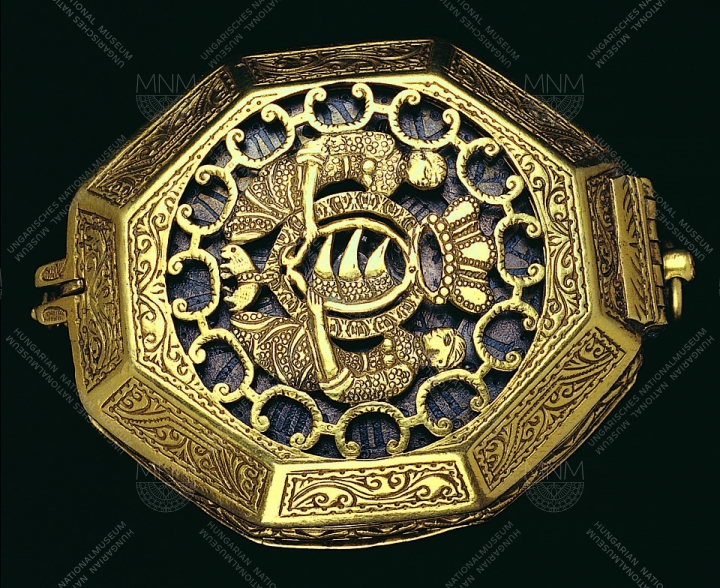
Pocket Watch
It was purchased by the National Museum from the collection of Miklós Jankovich in the 1830s. In the 18th century the earliest samples of pocket watches were worn around the neck or hanging from a belt by the aristocracy. These pocket watches were generally listed among jewellery in inventories because they had been made of silver, gold (often gold-plated copper), and often decorated with precious stones or enamel decorations; their lids covered with polished mountain crystals. The labour-intensive pieces mostly came from the centers of watch production: Augsburg or Nuremberg. However, watchmakers were already united in guilds in Hungary and Transylvania. This outstanding piece of our collection belonged to Zsigmond Báthori, Prince of Transylvania (1581-1602). Its case is octagonal shaped and made of enamelled brass. The lower part of the case had been made earlier,somewhere between 1570-1580, with pierced andengraved flower motifs. Its cover part is decorated with the dragon-tooth coat of arms of the Báthoris, surrounded by the chain of the Order of the Golden Fleece. Zsigmond Báthori received the rank of the Prince of Transylvaniaand the Order of the Golden Fleece in 1597, so the lid cover could have been made after that date. It is most likely a masterpiece made by a Transylvanian watchmaker master. It is constructed with only one hand, its twisted escapement supports a clockwork; its balance wheel is madewithout a hairspring.
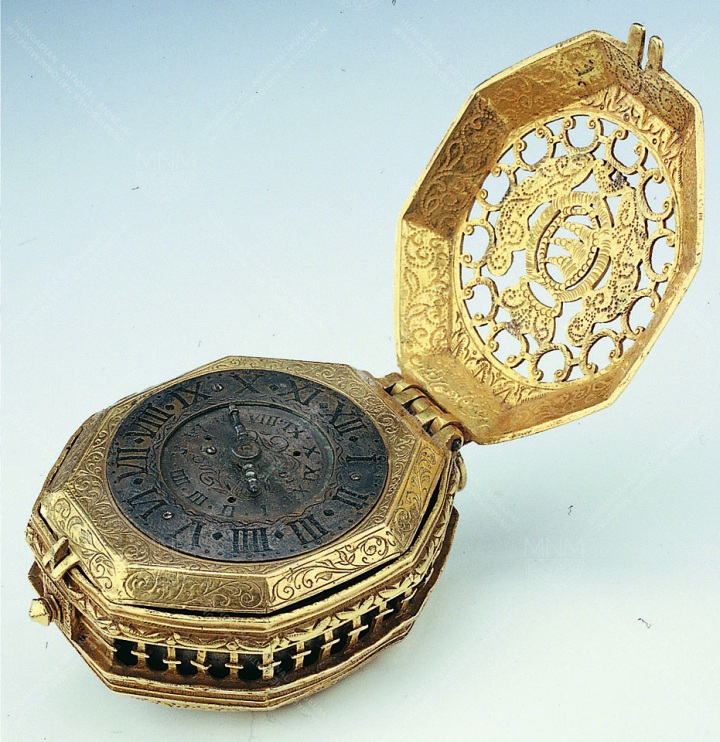
Cross clock
Master mark: "Me Fecit Adamus Bachmedjei A.D. 1693"
gold-plated brass with twisted clockwork
Cross clocks were very popular in Europe in the 16th-17th centuries. The pedestal houses a structure that rotates a sphere placed on top of the crucifixindicating the time (with Roman numbers)along a vertical axis. In fact there is a hand fixed in front of the sphere ring indicating the time..
In the middle of the 19th century, the parish priest of Ebed, Mihály Nagy donated his clock in his last will to the National Museum, therefore it was included in the collection. In the booklet published for the 100th anniversary of the National Museum (1902), a picture was published about the clock: "A skillfully composed clockdesigned in the shape of a cross with a small bell. We can read the name of a fine Hungarian master under the bell." According to the Latin inscription, Master Ádám of Bács County made it in the year 1693 of the Lord.
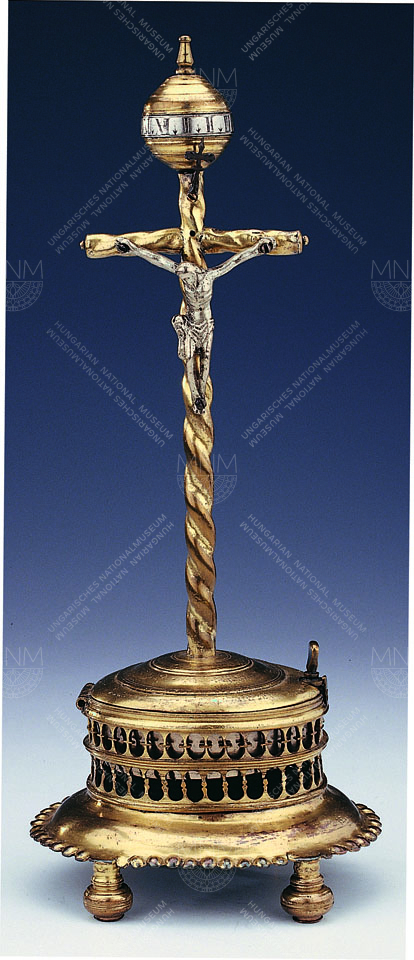
Wall Clock
master mark: Matthias Kieblich in Pressburg
second half of the 17th century, Bratislava
One of the earliest pieces of our collection is this gold-plated copper-framed watch, which had been owned by Ferenc Rákóczi II according to the tradition. In addition to the ornate frame, two lions hold an oval silver shield. On the dial two young gentlemen are figting a three-headed, fire-blowing dragon. The master mark engraved on the clockwork says: Matthias Kieblich in Pressburg.

Cylindrical Sundial
signed by Michael Sichulsky, Bardejov, 1745.
For thousands of years, sundials were the most reliabletime measuring devices. The skill to design a sundial, gnomonics (a gnomon is a stick casting shadows around which circles are drawn to find about the position of the Sun judging by the shadows of the gnome), became the science in the ancient Hellas. The two large groups of sundials are the fixed and portable (portative) ones. There are many subtypes within each group. Portable sundials spread from the 15th century to a wider range when more and more accurate time measuring pieces were needed in everyday life. The heyday of pocket sundials was in the 18th century when the more expensive mechanical clocks were replaced with them.
The cylindrical sundial is based on the measurement of the Sun's height. The signs are distributed on the cylinder's hull and the shadow is cast on them by the gnomeplaced horizontallyon the upper part. This piece is also an outstanding piece being able to measure quartets as well. According to its Latin mark "it was draw by Mihály Sichulsky, an organist and singer in Bártfa (Bardejov), at 48 degrees of pole height in 1745.
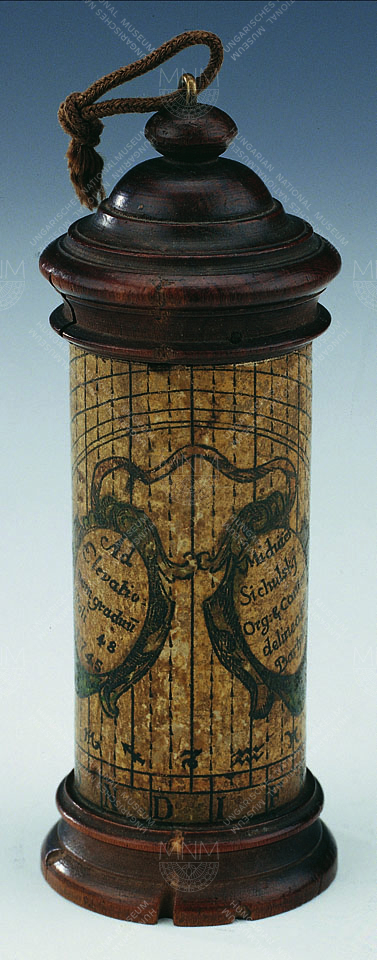
Astrolabe
no master mark
South German or Flemish work, 16th century
gilt copper
This sophisticated gold-plated brass disk: an astronomical clockcombined with an astrolabe is a significant piece of the clock collection of the Hungarian National Museum. An astrolabium is used to determine the paths and temporary places of planets, a model of the Ptolemaic universe, the most widely used scientific astronomical tool of the European Middle Ages and the Renaissance, aninstrument designed to make awide range of measuring and calculating tasks.
An astrolabium is built on a circular base plate („mater”) with an angular arrangement and clock division around the edge. To the front side of the base plate, an (or more) angled smaller plate, a tympanum can be fitted. It was where the horizontally casted picture of the sky's graduation was engraved. The zodiac ring depicts the zodiac constellationswith the names of zodiac signs.This ring – containingspikes representing 28bright star can be rotated ring, the net.
The arrangement of this instrument differs somewhat from the general system of astrolabes. Its back – containing a night clock (nocturnalium) – is unfortunately incomplete. There are two rotating disks on the back, one of hte watch arms is missing. It is decorated with the engraved picture of the Aries sign. The engraved Latin names also show that the instrument could have been made before the 17th century.
It is an interesting, unique piece.
